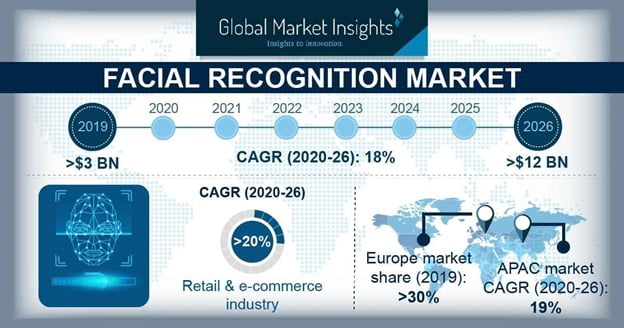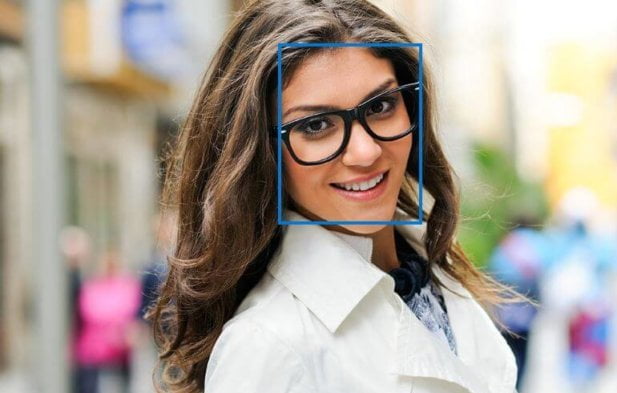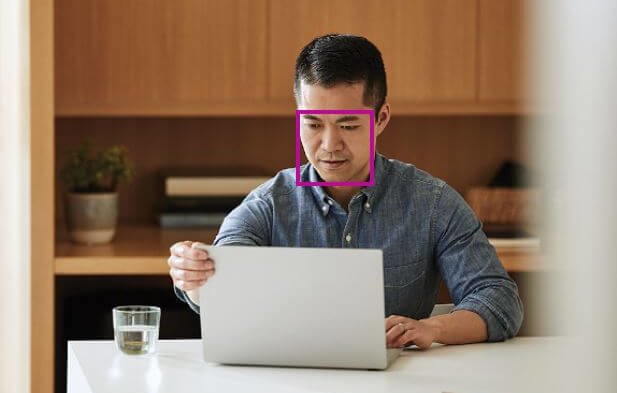The essentials of facial recognition technology
Facial recognition is a biometric technology that uses uniquely distinguishable facial features to identify a person. Consequently, a facial recognition solution uses biometrics to map facial features from a photograph or video and compares the information with a database of known faces to find a match.
Today, more and more industries have implemented biometric facial scanning into their everyday tasks. The facial recognition process is used in a variety of ways from allowing you to unlock your phone, go through security at the airport, or even purchase products at stores.
Allied Market Research expects the facial recognition market to grow to $9.6 billion by 2022.
According to Global Market Insights, the facial recognition market size surpassed USD 3 billion in 2019 and is predicted to grow at a CAGR of over 18% between 2020 and 2026. That is because of the rapid adoption of advanced face recognition systems for security and identification.

How does facial recognition work?
Let’s take, for example, a real situation: you can identify the face of a family member, friend, or acquaintance because you are familiar with their facial features – their eyes, nose, mouth – and how they come together.
That’s how a facial recognition system works, but on an algorithmic scale. While you see a face, the recognition technology sees data, which can be stored and accessed.
So how does facial recognition work?
The technologies used may vary but below you can find out a few basic steps common to most solutions:
- Facial detection: the camera will detect and recognize your face, either alone or in a crowd. It works best if the person is looking directly at the camera;
- Facial verification: a photo of your face is captured and analyzed. A facial recognition algorithm processes the geometry of your face and identifies the facial landmarks that are key to distinguishing your face;
- Facial signature: the analysis of your face is then turned into a mathematical formula. The face analysis is converted into a code called faceprint;
- Facial recognition: your faceprint is then compared, with the help of machine learning and artificial intelligence capabilities, to other data stored in facial recognition databases to determine identity.
Advantages of using facial recognition across software solutions
One of the major advantages of facial recognition technology is safety and security, which can result in diminishing the risk of fraud.
Another great benefit of using facial recognition is the fact that it’s an automated system that offers a quick and seamless verification experience, unlike other security measures. There is nothing such as a key or ID that can be lost or stolen.
Besides, facial recognition can streamline the user experience. It will not only help you tag photos on Facebook or your cloud storage via Apple and Google but you will start also to be able to check-out at stores without pulling out money or credit cards.
How can Facial Recognition feature help in the Onboarding process?
Over the last years, we have seen an increase in the use of technology in many business sectors to simplify things and better engage customers, especially in the banking and finance sector. Since the early days of digital transformation, facial recognition has been gaining notability due to the convenience it offers without compromising on the security of transactions.
Many banking institutions switched from conventional methods to biometric facial recognition to verify the customer’s identity. The goal would be to authenticate the identity and only allow a transaction to go through if the account owner’s identity is positively identified.
Visual identification with Selfie and Video Call in a Digital Onboarding for Banking solution
The Face Recognition analysis is done in two steps:
| Detection
___
Image source: azure.microsoft.com Based on a machine learning algorithm, this will identify specific face attributes such as estimated age, smile intensity, sex, facial hair, blur level, noise, exposure. The facial detection is based on approximately 27 point landmarks/positions specific to a human face. This functionality will be applied to both selfie and ID card pictures after the selfie photo was taken.
|
Verification
___
Image source: azure.microsoft.com Based on the output from step 1, this will perform a cross-check between the pictures and generate a confidence score as per an agreed algorithm. Comparing the ID card picture and the selfie will provide a confidence score. This score will be used as input for the decision engine; the confidence score will not be displayed to the user; instead, this information will be exposed via an API to the decision engine. Following industry best practices, anything above 0.5 confidence score is considered to be possibly identical. |
How can Encora help you?
To help you drive your financial capabilities to the next level, you need a real-time identity verification solution that can deliver a seamless user experience for your customers and ensure protection for your organization.
We can build tailored visual identification solutions for customer onboarding on platforms like Microsoft Azure or eID, to help you ensure the security of your services and reduce the risk of fraud.
Learn more about our Digital Onboarding Software Solutions and how we can help you.
Resources:
https://www.gminsights.com/industry-analysis/facial-recognition-market
https://www.alliedmarketresearch.com/facial-recognition-market





